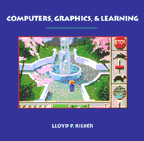
Our sense of vision represents our richest source of information.
Computer learning environments pose particularly exciting and demanding situations for visual communication. The range and diversity of visualization that computers offer are unprecedented. The last 10 years have demonstrated marked increases in sophistication in the graphics produced and displayed on computers. The success of desktop microcomputer systems integrating graphical user interfaces (GUIs), such as the Macintosh computer, can be largely attributed to the dramatic rethinking of how people should interact with computers. The principal reason to highlight the computer in the design and development of instructional graphics is the computer's increasing range, versatility, and flexibility of graphic design. There is almost no graphic design need that the computer cannot serve. In addition, the design of computer graphics is no longer limited to delivery on computer platforms. The unprecedented spread of desktop publishing is a prime example of the computer as a design and production tool, though the delivery platform is paper.
"Microworlds are among the most promising attempts at creating computer environments that foster an individual's construction (assimilation and accommodation) of knowledge."
|
Instructional designers should be most interested in ways to increase the likelihood that information will be dual encoded in long-term memory.
|
"Provide a meaningful learning context that supports intrinsically motivating and self-regulated learning." |
Information encoded in both verbal and visual forms with strong and flexible links between the codes should enhance retention, retrieval, and transfer. Dual coding is more likely to occur when the content lends itself to imaging.
Microworlds, though a constructivist invention, offer instructional designers two key advantages. First, microworlds present learners with experiences within specific boundaries of a domain. Second, microworlds offer learners "stepping stones" between interconnected ideas within the domain by allowing rudimentary ideas to first become established and then transformed into more sophisticated aspects of the domain.
Even the most specific design principles can be traced to one of four broad categories of visual design and layout: simplicity, unity, emphasis, and balance. An easy way to understand the importance of these four principles is simply to consider the effect of their opposites -- complexity, disorganization, sameness, and imbalance.
Read more about using computers and graphics in education in Lloyd P. Rieber's online version of this free to read book.
to page 4 |